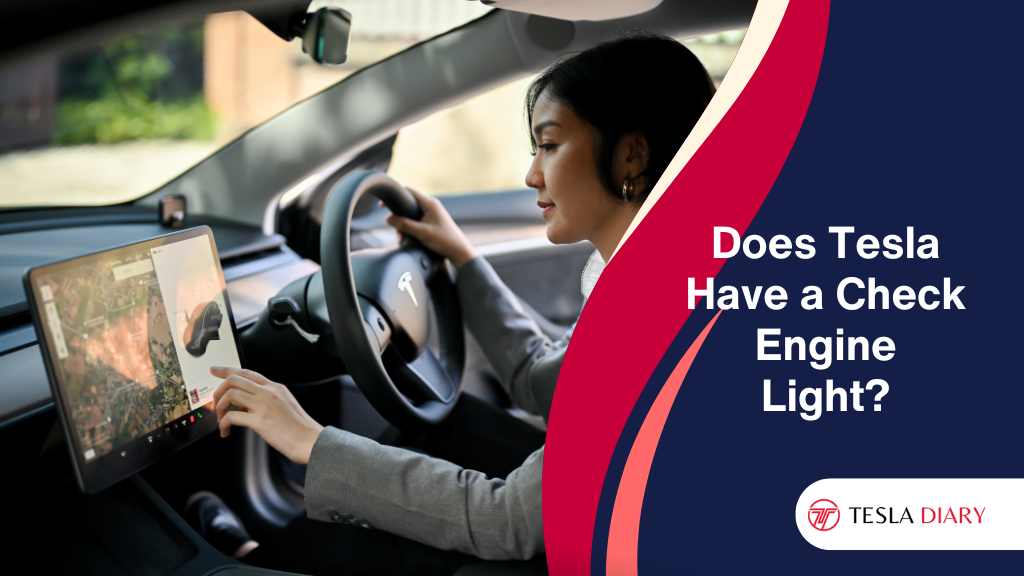When it comes to electric vehicles (EVs), Tesla is a name that often comes to mind. Known for its innovative technology and sleek designs, Tesla has revolutionized the automotive industry.
However, one question that frequently arises among potential Tesla owners and enthusiasts is whether Tesla vehicles have a “Check Engine Light” similar to traditional gasoline-powered cars.
In this article, we’ll explore the presence of a check engine light in Tesla vehicles and how it differs from conventional cars.
Tesla cars do not have traditional check engine lights. Instead, errors in the system are notified via the large touchscreen display that all Tesla models come equipped with. Tesla’s constant vehicle health monitoring system shows specific error messages on the screen for you to understand and fix issues easily.
The Traditional Check Engine Light
Before delving into Tesla’s approach to warning indicators, it’s essential to understand the traditional check engine light found in most gasoline and diesel-powered vehicles.

This warning light, often displayed as an icon of an engine or simply the words “Check Engine,” serves as an early warning system for potential issues with the vehicle’s engine and emissions systems.
When the check engine light illuminates on a traditional vehicle, it typically indicates that the vehicle’s onboard computer, known as the Engine Control Module (ECM) or Powertrain Control Module (PCM), has detected a problem.
This problem could range from minor issues like a loose gas cap to more severe concerns such as a malfunctioning sensor or a critical engine component failure.
Tesla’s Approach to Vehicle Health Monitoring
Tesla takes a different approach to vehicle health monitoring compared to traditional combustion-engine vehicles.
Instead of a single “Check Engine Light,” Tesla vehicles are equipped with a sophisticated system known as “Tesla Vehicle Health.”
This system continuously monitors various aspects of the car’s performance, providing real-time feedback to both the vehicle owner and Tesla’s service team.
Key Features of Tesla Vehicle Health:
1. Constant Monitoring:
Tesla’s onboard computers continually analyze the condition and performance of various vehicle components, including the battery, motor, sensors, and software.
This constant monitoring allows the system to detect potential issues proactively.
2. Diagnostic Alerts:
When Tesla’s Vehicle Health system detects a problem, it doesn’t rely on a single warning light. Instead, it provides specific diagnostic alerts that are displayed on the vehicle’s touchscreen interface and transmitted to Tesla’s servers.
These alerts can include detailed information about the problem, its severity, and recommended actions.
3. Over-the-Air Updates:
One of Tesla’s most significant advantages is its ability to perform over-the-air software updates. This means that Tesla can diagnose and, in some cases, even fix issues remotely without the need for a physical visit to a service center.
This approach enhances convenience and minimizes downtime for Tesla owners.
4. Mobile App Integration:
Tesla owners can access their vehicle’s health status through the Tesla mobile app.
This allows them to check their vehicle’s condition and receive notifications on their smartphones, keeping them informed even when they’re away from the car.
5. Predictive Maintenance:
Tesla’s Vehicle Health system can often predict potential issues before they become critical, thanks to its continuous data analysis.
This predictive maintenance capability helps prevent breakdowns and reduces repair costs.
Differences Between Tesla’s Approach and Traditional Check Engine Lights
While Tesla’s Vehicle Health system serves a similar purpose to a traditional check engine light, there are several notable differences between the two:
1. Continuous Monitoring vs. Passive Warning:
Tesla’s system is actively monitoring the vehicle’s condition at all times, providing real-time feedback.
In contrast, traditional check engine lights only illuminate when a problem is detected during the vehicle’s self-check or when a sensor triggers it.
2. Detailed Diagnostic Information:
Tesla’s system provides detailed diagnostic information about detected issues, while a traditional check engine light often requires additional diagnostic tools to determine the problem’s exact nature.
3. Proactive vs. Reactive:
Tesla’s approach is proactive, aiming to detect and address issues before they cause significant problems. Traditional check engine lights, on the other hand, are reactive, signaling a problem after it’s already occurred.
4. Remote Diagnostics and Updates:
Tesla’s ability to diagnose and address some issues remotely, via over-the-air software updates, sets it apart from traditional vehicles, which typically require a physical visit to a service center.
Responding to Tesla Vehicle Health Alerts
When a Tesla owner receives a Vehicle Health alert, there are several steps they can take to address the issue:
Review the Alert: Carefully read the alert message on the vehicle’s touchscreen or in the mobile app. This message will provide information about the problem and suggested actions.
Contact Tesla Support: If the alert indicates a critical issue or you’re unsure how to proceed, it’s advisable to contact Tesla’s customer support or visit a Tesla service center. They can provide guidance and assistance.
Scheduled Service: For non-urgent issues, Tesla owners can schedule a service appointment through the mobile app. Tesla’s service technicians will diagnose and address the problem at a convenient time.
Over-the-Air Updates: In some cases, Tesla may release a software update to resolve a detected issue. Tesla owners should ensure their vehicles are set to receive over-the-air updates automatically.
Monitor Remotely: Owners can continue to monitor their vehicle’s health status remotely via the Tesla mobile app. If the issue persists or worsens, they can take appropriate action.
Conclusion
While Tesla vehicles do not have a traditional “Check Engine Light” like conventional gasoline-powered cars, they offer a more advanced and proactive approach to vehicle health monitoring through the Tesla Vehicle Health system.
This system continuously monitors the car’s performance, provides detailed diagnostic alerts, and even allows for remote diagnostics and updates.

